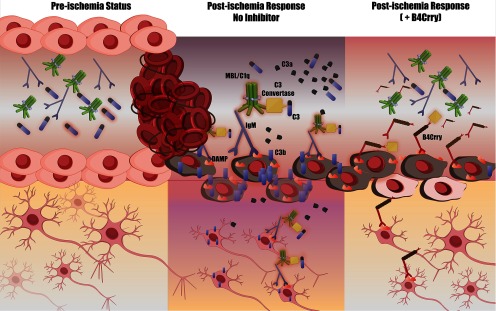Figure 9.
Illustration of mechanism of action of B4Crry. Left panel, In the normal brain, endothelial cells, neurons and other parenchymal cells do not express stress-related antigens. Middle panel, Following ischemic insult, the expression of neoepitopes (or danger associated molecular patterns, DAMPs) is induced on the surface of these cells. One such neoepitope expressed in the postischemic murine brain is a post-translational modification of Annexin IV, which is recognized by the B4scFv targeting moiety used in this study. In the absence of complement inhibition, this neoepitope (and others) engages circulating natural IgM antibodies and activate complement, leading to the assembly of the C3 convertase and subsequent generation of C3b opsonins and C3a anaphylatoxin. Right panel, The fusion protein B4Crry binds specifically to sites of B4-DAMP expression, thus competing with IgM binding of B4 specificity, while simultaneously inhibiting the activity of the C3 convertase via its Crry component. This ultimately leads to the interruption of the neuroinflammatory cascade that is otherwise activated on endothelial cells and neurons.

